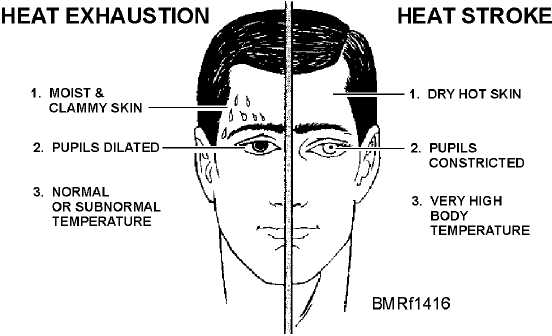Look at figure 14-16. Here, you see a comparison of
the symptoms of heatstroke and heat exhaustion. These
are dangers you face when working or exposed to
conditions that might cause heatstroke or heat
exhaustion.
HEATSTROKE
Sunstroke is more accurately called heatstroke
since it is not necessary for a person to be exposed to the
sun for this condition to develop. It is a less common but
far more serious condition than heat exhaustion, since
heatstroke has a 20% mortality rate. The more
important feature of heatstroke is the extremely high
body temperature (105 F [41 C] or higher) that
accompanies it. In heatstroke, the victim has a
breakdown of the sweating mechanism and is unable to
eliminate excessive body heat built up while exercising.
If the body temperature rises too high, the brain,
kidneys, and liver may be permanently damaged.
Signs and symptoms of heatstroke. Sometimes
the victim may have preliminary symptoms such as
headache, nausea, dizziness, or weakness. Breathing
will be deep and rapid at first, later shallow and almost
absent. Usually the victim will be flushed, very dry, and
very hot. The pupils will be constricted (pinpoint) and
the pulse fast and strong.
Treatment of heatstroke. When you provide first
aid for heatstroke, remember that this is a true
life-and-death emergency. The longer the victim
remains overheated, the higher the chances of
irreversible body damage or even death. First-aid
treatment for heatstroke is designed to reduce body heat
and includes the following:
Reduce body heat immediately by dousing the
body with cold water, or applying wet, cold
towels to the whole body.
Move the victim to the coolest possible place and
remove as much clothing as possible.
Maintain an open airway.
Place the victim on his or her back, with the head
and shoulders slightly raised.
If cold packs are available, place them under the
arms, around the neck, at the ankles, and on the
groin.
14-19
Student Notes:
Figure 14-16.—Symptoms of heatstroke and heat exhaustion.


